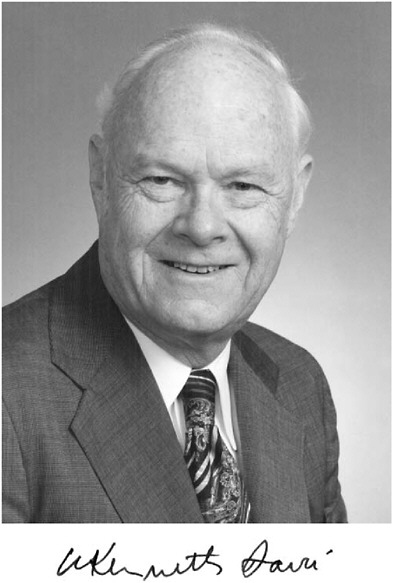W. KENNETH DAVIS
1918–2005
Elected in 1970
“For contributions to the development of nuclear power technology and its industrial application.”
BY HAROLD K. FORSEN AND WILLIAM L. FRIEND
W. KENNETH (Ken) DAVIS, a leader of the World Energy Council, former vice president of the National Academy of Engineering, former Deputy Secretary of Energy, and Bechtel Corporation executive, and one of the nation’s most distinguished chemical engineers, died on July 29, 2005, at the age of 87 at his home in San Rafael, California.
Ken was born in Seattle, Washington, but moved when he was young to the San Francisco Bay Area. He began his education at the University of California, Berkeley, where he studied chemistry before transferring to Massachusetts Institute of Technology (MIT) to become a chemical engineer. He received his B.S. and M.S. from MIT in chemical engineering in 1940 and 1942, respectively.
In 1947, after working for several years in the research department of what is now the Chevron Oil Company doing process design and the development of synthetic rubber, he joined Ford, Bacon & Davis (FB&D) in Chicago, a company that had won the contract to build the nation’s first nuclear engineering laboratory at Argonne, Illinois. Thus began Ken’s career in the newly emerging field of nuclear energy.
Ken left FB&D in 1949 to begin an academic career at the University of California, Los Angeles (UCLA). Encouraged by Llewellyn Boelter, now dean at UCLA, who was a close professional friend whom he met at Berkeley, Ken took a position at
UCLA in the engineering school, with the challenge that he develop courses in nuclear engineering. Early in his career at UCLA, he was asked by his former associates at Chevron to rejoin them to work on a large radiation project for the Atomic Energy Commission (AEC), so he took a one-year leave of absence. Ken’s work on the classified accelerator project, which later became the Lawrence Livermore National Laboratory, stretched his leave from the university to three years. Upon his return to UCLA, he was promoted to full professor.
In 1954, Ken was recruited to join the AEC, which was charged with managing the development of the nuclear navy and civilian nuclear power. He began as assistant director and then, for four years, director of the Reactor Development Division. Civilian nuclear power was the driving force in the development of the division, and Ken Davis was its champion.
Ken became a corporate vice president at Bechtel Corporation in 1958 and was instrumental in developing the company’s role in the rapidly emerging civilian nuclear industry. He was the first manager of Bechtel’s Scientific Development Division, which was organized to provide the company with capabilities in applied research, development, and advanced engineering and the application of these skills, particularly in the electric power sector. By this time, Ken was known as “Mr. Nuclear”—one of the world’s truly outstanding engineers. He retired from Bechtel in 1981 to become Deputy Secretary of Energy during the Reagan administration.
In 1970, Ken was elected to the National Academy of Engineering; he served on the NAE Council from 1972 through 1981, the last three years as vice president of the organization. During those years, he was also president of the American Institute of Chemical Engineers (1981), fellow and director of the American Nuclear Society, chair and president of the Atomic Industrial Forum and Atlantic Council of the United States. He then moved to the world stage as vice chair of the World Energy Council and chair of the U.S. Committee for the World Energy Council. Ken’s remarkable achievements were essential to the development of peaceful uses for nuclear energy. On the less technical side, Ken was a member of the Commonwealth Club of San
Francisco and the Cosmos Club in Washington, D.C., and a Life Member of the Sierra Club.
Ken’s many awards over the years included the Arthur S. Flemming Award (1956); AIChE Professional Progress Award (1958), Robert E. Wilson Award (1969), and Founders Award (1983); the American Nuclear Society’s Walter H. Zinn Award (1983) and Henry DeWolf Smyth Nuclear Statesman Award (1993); the Atomic Industrial Forum Oliver Townsend Award (1981); and the Secretary of Energy’s Gold Medal (1983). Ken was also a participant in many National Research Council studies and a member of many advisory boards during several federal administrations.
An avid and excellent skier and expert rock climber, Ken was one of a group of three climbers to make the first ascent of the Royal Arches route at Yosemite’s North Dome (1936). Later in his life, he went on two high treks in the Himalayas.
Ken’s wife, the former Margaret Bean, an accomplished pianist and composer, died in 1998 after 57 years of marriage. The couple had three children and five grandchildren.
Ken Davis was surely one of the “fathers” of the nuclear age and an influential leader, technologist, and statesman. Today, nuclear energy generates about one-fifth of the nation’s electricity, and considering the effects and consequences of global warming, we are likely to become increasingly dependent on safe, reliable nuclear power. In large measure, we will have Ken Davis to thank for it!
Ken is survived by his second wife, Ann Nilsson Davis of San Rafael; a brother, Keith Davis of Grand Lake, Colorado; two daughters, Kerry Davis of Kentfield and Gail Greene of Novato; a son, Warren Davis of Lafayette; and five grandchildren.
ACKNOWLEDGMENTS
Some material was taken from an obituary in the San Francisco Chronicle on August 15, 2006, by John Wildermuth; an interview with Mr. Davis by Professor William Van Vorst, UCLA (2005); and Mr. Davis’ biography provided to the National Academy of Engineering.





